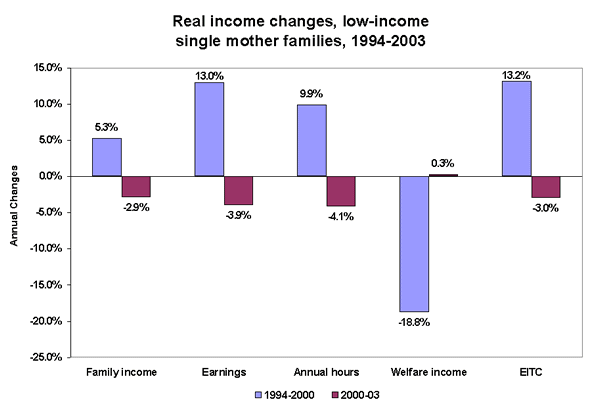See Snapshots Archive.
Snapshot for October 6, 2004.
“Safety net” fails single mothers during downturns
In the era of welfare reform, one measure of the effectiveness of economic policy is the ability of the “safety net” to protect economically vulnerable families over the course of a recession and jobless recovery. In the most recent downturn, however, the safety net failed to adequately protect one particularly vulnerable group—low-income single mothers—from income losses.
Historically, programs such as welfare, unemployment insurance, and food stamps have helped to mitigate the impact of downturns on the least advantaged. Economists call such programs “counter-cyclical” because expenditures in these areas rise when employment and incomes decline; thus, they are intended in part to counter the effects of the business cycle. Conversely, pro-cyclical programs are those that boost incomes when the business cycle is expanding.
The figure suggests that the safety net for low-income single mothers is failing to prevent their incomes from contracting, in part due to the pro-cyclical effects of the Earned Income Tax Credit (EITC). The EITC is an extremely valuable wage subsidy that can add over $4,000 to the annual income of a low-income family with children. However, when work disappears, EITC income can also decline, as was the case for this group of low-income mothers in the most recent recession.

Over the 1990s, pulled by the tightening of the job market, the higher value of the minimum wage, and an expanded EITC, and pushed by welfare reform, increasing numbers of single mothers went to work. As the figure shows, their annual hours worked, earnings, and EITC benefits grew quickly over this period, while their welfare income fell sharply.
Over the 2000-03 period, these trends reversed. Employment and earnings contracted, and welfare income reversed course, showing that the traditional safety net did kick in to some extent (unemployment benefits, included in the income category in the figure, also rose). But the value of EITC benefits contracted by 3% per year, and family income fell at about that same rate.
For low-income single mothers, the safety net appears to be evolving toward a system that strongly boosts incomes in good times but fails to prevent losses in bad times. To reverse this trend, policy makers need to both strengthen some of the counter-cyclical policies weakened by welfare reform and improve the functioning of other programs, such as unemployment insurance compensation, that are designed to prevent income losses when jobs disappear.
Note: Data are from the Census Bureau’s March Current Population Survey. Low-income single families are defined as those whose income/poverty threshold is below the median for this family type (about $20,000 in 2000). This so-called “income-to-needs” ratio adjusts income for family size. The EITC values are imputed by the CPS, except for 2003 values which were imputed by the author using EITC parameters for that year (since the March CPS for 2003 was released without the needed EITC imputation). Running this same algorithm on earlier years matched the CPS imputation, suggesting that this generates a similar result to that of the Census Bureau.
This week’s Snapshot was written by EPI senior economist Jared Bernstein.
